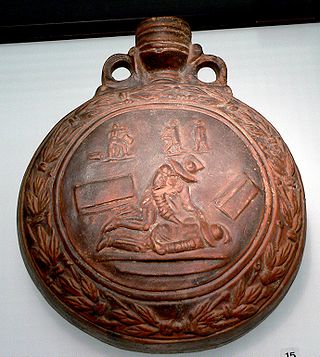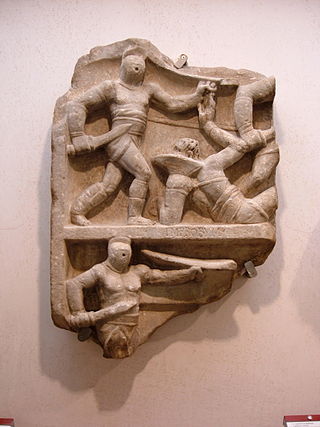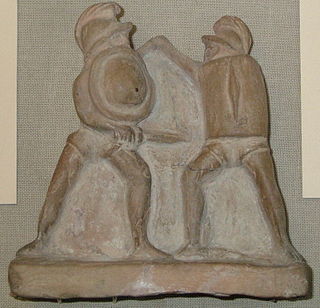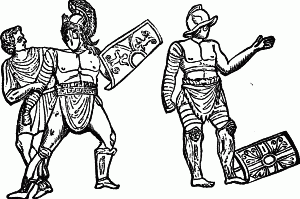
A gladiator was an armed combatant who entertained audiences in the Roman Republic and Roman Empire in violent confrontations with other gladiators, wild animals, and condemned criminals. Some gladiators were volunteers who risked their lives and their legal and social standing by appearing in the arena. Most were despised as slaves, schooled under harsh conditions, socially marginalized, and segregated even in death.

The First, Second, and Third Samnite Wars were fought between the Roman Republic and the Samnites, who lived on a stretch of the Apennine Mountains south of Rome and north of the Lucanian tribe.

The Samnites were an ancient Italic people who lived in Samnium, which is located in modern inland Abruzzo, Molise, and Campania in south-central Italy.
The Battle of Sentinum was the decisive battle of the Third Samnite War, fought in 295 BC near Sentinum, in which the Romans overcame a formidable coalition of Samnites, Etruscans, and Umbrians and Senone Gauls. The Romans won a decisive victory that broke up the tribal coalition and paved the way for the Romans' complete victory over the Samnites. The Romans involved in the battle of Sentinum were commanded by consuls Publius Decius Mus and Quintus Fabius Maximus Rullianus.

The murmillo was a type of gladiator during the Roman Imperial age. The murmillo-class gladiator was adopted in the early Imperial period to replace the early Gallus, named after the warriors of Gaul. As the Gauls inhabiting Italy had become well integrated with the Romans by the time of the reign of Augustus, it became undesirable to portray them as enemy outsiders; the Gallus-class gladiator thus had to be retired.

A secutor was a class of gladiator in ancient Rome. Thought to have originated around 50 AD, the secutor was armed similarly to the Murmillo gladiator and like the Murmillo, was protected by a heavy shield. A secutor usually carried a short sword, a gladius, or a dagger. The secutor was specially trained to fight a retiarius, a type of lightly armoured gladiator armed with a trident and net.

A retiarius was a Roman gladiator who fought with equipment styled on that of a fisherman: a weighted net, a three-pointed trident, and a dagger (pugio). The retiarius was lightly armoured, wearing an arm guard (manica) and a shoulder guard (galerus). Typically, his clothing consisted only of a loincloth (subligaculum) held in place by a wide belt, or of a short tunic with light padding. He wore no head protection or footwear.

The gladiatrix is the female equivalent of the gladiator of ancient Rome. Like their male counterparts, gladiatrices fought each other, or wild animals, to entertain audiences at various games and festivals. Very little is known about them. They seem to have used much the same equipment as male gladiators, but were heavily outnumbered by them, and were almost certainly considered an exotic rarity by their audiences. They seem to have been introduced during the very Late Republic and early Roman empire, and were officially banned as unseemly from 200 AD onwards. Their existence is known only through a few accounts written by members of Rome's elite, and a very small number of inscriptions.

The Battle of Vesuvius was the first recorded battle of the Latin War. The battle was fought near Mount Vesuvius in 340 BC between the Romans, with their allies the Samnites, against a coalition of several peoples: Latins, Campanians, Volsci, Sidicini, and Aurunci. The surviving sources on the battle, however, focus almost solely on the Romans and the Latins.

The Battle of Lautulae was fought in 315 BC during the Second Samnite War, opposing the Roman Republic and the Samnites, who defeated the Romans.

The Thraex, or Thracian, was a type of Roman gladiator, armed in the Thracian style with a small rectangular, square or circular shield called a parmula and a very short sword with a slightly curved blade called a sica, intended to maim an opponent's unarmoured back. His other armour included armoured greaves, a protective belt above a loincloth, and a helmet with a side plume, visor and high crest. Ludia's female gladiators used the same weapons and armour.

A hoplomachus was a type of gladiator in ancient Rome, armed to resemble a Greek hoplite. The hoplomachus would wear a bronze helmet, a manica on his right arm, loincloth (subligaculum), heavy padding on his legs, and a pair of high greaves reaching to mid-thigh. His weapons were the spear and a short sword. He was often pitted against the murmillo, perhaps as a re-enactment of Rome's wars in Greece and the Hellenistic East. The name hoplomachus means 'armored fighter'. The small, round shield was as much a weapon as a sword or spear, not unlike the original hoplites, who used it primarily for defensive purposes, but also employed it in their charges, using it to ram their opponents at the onset of a fight. They wore no shoes so the sand would chafe their feet, presenting them a greater challenge.

The Gladiator Mosaic is a famous set of 5 large mosaics of gladiators and venators and two smaller ones. The mosaics are dated to the first half of the 4th century and are now installed in the Salone of the Galleria Borghese in Rome. They were discovered in 1834 on the Borghese estate at Torrenova, on the Via Casilina outside Rome. Prince Francesco Borghese Aldobrandini requested the excavations be completed. It is believed to have decorated a cryptoporticus of an inner peristylum for a large domus. The mosaics were removed from excavations and restored by Gaetano Ruspi and Filippo Scaccia in 1839. These panels reinvigorated the Borghese Collection after it had shrunk following the sale of much of the collection to Napoleon I.
The laquearius, laquerarius, or laqueator was a class of Roman gladiator that fought with a lasso or noose (laqueus) in one hand and a poniard or sword in the other. The laquearius appeared late in the history of the Roman games. They may have made up a full-fledged gladiator class that fought actual bouts in the arena. If this was the case, the snarer likely followed the same tactics as the retiarius, a gladiator who wielded a throwing net and trident. Such combat-oriented laquearii fought by attempting to snare their adversaries with the lasso to allow for a follow-up strike from the blade. The snarer's armour was probably similar to that of the retiarius; it consisted mainly of a retiarius armguard worn over the left shoulder. Another possibility is that the laquearius was a kind of paegniarius, or clown. These men fought mock battles in the arena as comic relief between real matches.
The scissor was a type of Roman gladiator. Very little is known about them and they were not mentioned after the first century BCE. The name, from the verb scindere means cleaver, carver, or slasher. Historian Marcus Junkelmann identified what he termed a scissor in a relief in the late 1980s. The figure, however, has also been identified as an arbelas by other historians. It is possible that the scissores went extinct or were later reclassed as arbelai. The scissores may have evolved from the secutor due to the similarity in armor, helmet, and gladius, as well as being "anti-retiarius."

Illyrian weaponry played an important role in the makeup of Illyrian armies and in conflicts involving the Illyrians. Of all the ancients sources the most important and abundant writings are those of Ennius, a Roman poet of Messapian origin. Weapons of all sorts were also placed intact in the graves of Illyrian warriors and provide a detailed picture for archaeologists on the distribution and development of Illyrian weaponry.

The Zliten mosaic is a Roman floor mosaic from about the 2nd century AD, found in the town of Zliten in Libya, on the east coast of Leptis Magna. The mosaic was discovered by the Italian archaeologist Salvatore Aurigemma in 1913 and is now on display at The Archaeological Museum of Tripoli. It depicts gladiatorial contests, animal hunts, and scenes from everyday life.
The dimachaeri were a type of Roman gladiator that fought with two swords. The name is the Latin-language borrowing of the Greek word διμάχαιρος meaning "bearing two knives".
A scutarius in Ancient Rome was any of the various types of gladiator who used a large shield called a samnite shield, which is named after another type of gladiator—a samnite. In Latin, the shield was called a scutum—where the name scutarius comes from. Due to having a large shield, scutarii would wear shin armour (ocrea) on their shield leg. This piece of armour would be smaller than the two ocreae worn by parmularii, who carried a smaller, though still somewhat large, shield. Scutarii also usually carried short swords and wore visored helmets. Scutarii and parmularii are mentioned by Marcus Aurelius in his Meditations as two factions at the gladiator fights—both as gladiators and people who supported those gladiators.
















